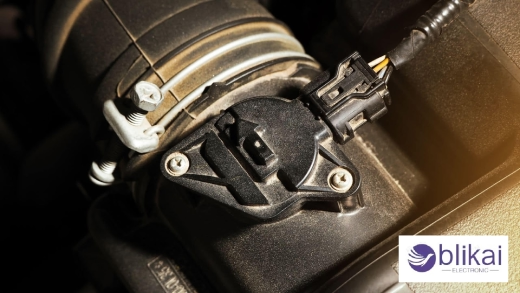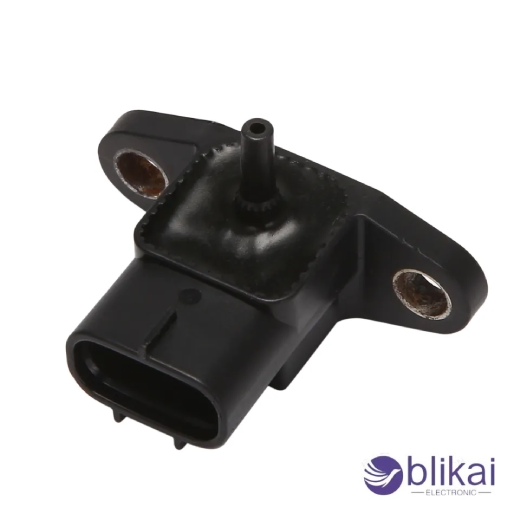MAP Sensor: Working Principles, Features and Types

There is a lot more intelligence in engines today. What's one reason for this? It is the MAP sensor. In short, it refers to the absolute pressure in a manifold. Doesn't that sound fancy? As a key player, it continually feeds real-time pressure data from the intake manifold to the ECU. It would be impossible for the engine to guess correctly without it. Are you mixing too much fuel? Too lean? MAP sensors help fix that problem. In order for the engine to perform well, it must breathe right, run smoothly, and perform efficiently. No matter what you're doing, this little sensor keeps everything balanced, whether you're cruising or flooring it.
What is a Map Sensor?

A MAP sensor. That sounds small. However, don't be fooled by its size. You can think of it as the lungs' translator for your engine. How does it work? This device measures the absolute pressure inside the intake manifold. Neither the outside air nor random guesses will suffice. A real-time, in-the-moment measurement of the pressure inside. What is the significance of that? That information is used by the ECU to adjust fuel injection and ignition timing, among other things. If you were to run a race while breathing through a straw, you would not be able to do it. Your engine would feel that way if it had a bad MAP sensor. The air-fuel mix becomes distorted if pressure readings aren't accurate. If the fuel is too rich, the engine bogs down. A lean mixture can cause the engine to misfire or even stall. Sensors talk to ECUs, and ECUs listen to sensors. A balance is achieved.
What's interesting about this is that it's not a modern technology trend. The MAP sensor has been around for quite some time, especially in older vehicles before MAF sensors became the norm. There are still many engines that use them today. Still pretty effective, but simpler and cheaper. A pressure difference is converted into an electrical signal using this device. Using that voltage, the ECU is able to determine the load on the engine. Is the load heavy? Fuel consumption and cruise speed? Don't overdo it. They don't just sit around. As the plane adjusts to hills, throttle changes, and even altitude changes, they are constantly responding, second by second. Considering that it's just a box and a vacuum port, it's pretty impressive.
Working Principle
What is the MAP sensor's job? It's simple. Data is sent to the ECU (engine control unit) based on the pressure inside the intake manifold. Is it really that simple? Things start to get interesting at that point. Manifold pressure changes are what start it all. Putting your foot on the gas pedal opens the throttle, letting more air into the engine. As a result, the manifold pressure drops. Conversely, when you release the throttle or the engine idles, the pressure increases. These fluctuations are constantly monitored by the MAP sensor. It does more than just detect them-it converts them into electrical signals that can be understood by the ECU.
You can think of the diaphragm inside the sensor as a flexible membrane. The sensor moves or bends based on the difference between the manifold and its internal reference chamber. By moving a piezoelectric element or capacitor, voltage is changed and the movement affects a piezoresistive element. It is possible to produce a high voltage when pressure is elevated (such as when you are at full throttle). Low voltage occurs when there is low pressure (such as when the engine is idling). Real-time fuel injection, ignition timing, and boost levels are adjusted by the ECU based on this voltage. Is it possible to read the MAP sensor incorrectly or if it fails? There are times when the engine runs too rich, too lean, or even enters limp mode. The air intake sensor plays a crucial role in ensuring the engine breathes properly because it is the link between the air intake and the ECU. You can also learn about the Flexible sensor in detail.
Features
Real-Time Air Pressure Monitoring
A MAP sensor's main feature is its ability to monitor air pressure in real time. It never sleeps. The engine's intake manifold pressure changes as the throttle is applied, the load is distributed, and the altitude is increased. A MAP sensor continuously reads those tiny shifts and relays them instantly to the ECU. Using that real-time tracking, the engine can adjust fuel-air mix and combustion more accurately on the fly.
Precision and Accuracy
There is no guessing involved with these sensors. Measurements are made. Exactly. A MAP sensor provides exact pressure values, whether you're stopping at a red light or accelerating down the highway. Poor engine performance and wasted fuel can result from even slight misreads. The purpose of modern MAP sensors is to maintain tight, reliable readings under changing conditions by using high-grade materials, such as piezoresistive or capacitive sensing elements.
Compact and Lightweight Design
It's tiny, like, really tiny. Despite its size, it packs a punch. In cramped engine bays, MAP sensors are easy to install due to their compact size. No extra space is required or bulky wiring is required. The lightweight and non-intrusive design allows them to blend in seamlessly, which is exactly what you'd want in a heat-filled underhood environment.
Built to Withstand Harsh Conditions
When an engine gets hot. Their vibrations are accompanied by moisture, oil, and dirt. In spite of this, the MAP sensor remains steadfast. High temperatures, vibrations, and occasionally splashes of fuel vapor are all part of its design. No matter whether you're cruising down the highway in summer or starting the engine in winter, its sealed body protects the internal electronics.
Fast Response Time
There is no lag or delay. Pressure sensors react almost instantly to changes in pressure. For functions such as acceleration, deceleration, and changing engine load, a quick response time is essential. If the sensor is slow, everything would be thrown off—just like if your GPS had 10 seconds to get directions. The MAP sensor maintains synchronization.
Direct Engine Load Sensing
MAP sensors measure engine load directly instead of measuring airflow as MAFs do. How? Intake manifold pressure can be detected by detecting pressure inside. When there is more pressure, the engine must work harder since more air is getting in. Less pressure? Idling or cruising is the state of the engine. Fuel injection and ignition timing can be adjusted quickly based on direct load measurements, keeping the engine at peak efficiency.
Works Independently of Airflow Sensors
A vehicle may be equipped with both a MAP and MAF sensor. It's important to note, however, that MAP sensors aren't totally dependent on airflow sensors. In many turbocharged engines, MAP sensors are the only means of measuring air intake. Since boost pressure changes with forced induction systems, airflow measurements can be inconsistent.
Altitude Compensation
Are you aware of how sluggish your car feels at high altitudes? There's less air up there because it's thinner. By using the MAP sensor, this can be compensated for. As it reads absolute pressure instead of sea level pressure, the ECU can adjust fuel delivery accordingly. Having this feature is crucial for vehicles that travel through mountainous areas where the density of the air constantly shifts.
Failsafe Operation with Error Detection
How do you handle a faulty MAP sensor? There will be no guessing on the part of the ECU. In most modern vehicles, MAP sensor issues are detected by built-in failsafe modes. ECUs switch to default air-fuel mapping if a sensor sends strange signals, although performance and efficiency might suffer. The check engine light (CEL) will even illuminate in some cars when there is a problem with the sensor.
Types
Analog MAP Sensor
It's the old-school type. Signals are spit out and it's simple. A change in pressure inside an intake manifold changes that voltage. As a result, the ECU calculates the engine load based on that signal. By adjusting fuel delivery and ignition timing, you can achieve optimum performance. Some setups don't require digital flashiness, so it's smooth, basic, and still used.
Digital MAP Sensor
Quite modern. An analog voltage signal is replaced with a digital frequency signal. Therefore, electrical noise is less likely to affect it. This is especially useful in engines with lots of electronic components. It's precise. It is also easier for the ECU to detect quick changes in pressure. The difference between AM and HD radio is comparable.
Vacuum MAP Sensor
There is a lot of reliance on vacuum pressure within the manifold for this one. The majority of engines that use it are naturally aspirated. There is a drop in vacuum when the throttle is opened. When that change occurs, the sensor detects it. An ECU gets its information about engine performance from the output. The key is not to boost raw power, but rather to breathe. The perfect solution for non-turbo setups that are simpler.
Boost MAP Sensor
Those who are interested in turbos pay attention here. There are two types of boost MAP sensors: those that measure vacuum and those that measure positive pressure (boost). The engine is designed for forced induction. As the turbo spools up, pressure spikes are captured by this sensor. When fuel and spark are adjusted, the ECU keeps things smooth under load and avoids knocks. This is especially important when you're pushing more air than the engine was designed to handle.
Wrapping Up
It might not look like much, but MAP sensors are important. There's just a little piece hidden in the intake. Yes, they are far more powerful than their size would suggest. Sensors like these provide your ECU with the raw truth about engine pressure without any fluff. Fuel, air, and spark are all in harmony with the MAP sensor, whether you're cruising or blasting. The entire system will stutter if it is missed. It's small, so yeah. What if it were absent? There is a rapid decline in engine performance.
What are Wireless Sensor Networks : All Explained
What is Optical Sensor ? Overview and Applications
Tilt Sensor Technology: Types, Advantages & Applications
How Do Motion Sensors Work? Types & Applications
What Steering Angle Sensor is :Principle,Features and Applications
ACS712 Current Sensor:Principle,Features and Applications
Analog and Digital Sensors:Types and Applications
MLX91221KDF-ABF-120-RE Melexis Current Sensor
Introduction to Current Sensor ABF025
Differential Pressure Sensor: Working, Applications and Types










